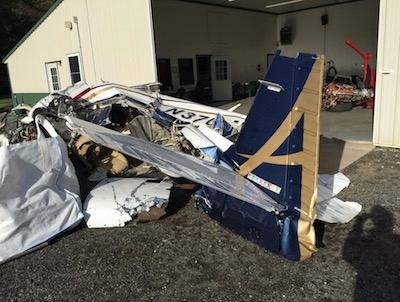NTSB Determines That Loose Connection Led To Depletion Of Oxygen Supply In Flight
A loose connection in an oxygen system used by the pilot of a Mooney M20 on a flight from Michigan to Atlantic City, NJ led to the fatal injured the pilot, according to the NTSB's probable cause report on the accident.

According to the report, the commercial pilot departed Michigan on a personal cross-country flight in the autopilot-equipped airplane destined for New Jersey. Air traffic control records indicated that after the airplane departed, about 1200, a controller instructed the pilot to climb to 25,000 ft mean sea level (msl). At 1216, the pilot read back the assigned altitude and continued toward the destination. About 23 minutes later, the controller attempted to contact the pilot; however, the pilot did not respond. Controllers' repeated attempts to contact the pilot throughout the remainder of the flight were unsuccessful as the airplane continued flying a straight course toward the destination.
According to radar data, about 2 hours 22 minutes after the pilot's last transmission and while about 5 miles northwest of the destination, the airplane began descending out of 25,000 ft msl while on a southeast heading until it impacted the Atlantic Ocean about 8 minutes later. Given that the pilot refueled the airplane several days before the flight and filed a flight plan that indicated that the airplane's fuel onboard would allow for 6 hours of flight, it is likely that both fuel tanks had 51 gallons of fuel onboard. Fuel consumption calculations indicate that the airplane would consume up to 22.6 gallons of fuel per hour at cruise flight at 25,000 ft.
Therefore, it is likely that the amount of fuel consumed on the day of the flight, given initial takeoff and climb consumption in addition to the 2 hours 22 minute cruise flight, would have been equivalent to the fuel available in one tank. Without pilot action to switch fuel tanks, the engine became starved of fuel and the airplane began its descent to the ocean. An examination of the airframe and engine revealed no preimpact anomalies that would have precluded normal operation.
During an examination of the oxygen system on the airplane, a fitting, which connected an oxygen line to a regulator on the tank, was found loose and could be moved in both directions by hand without resistance. The oxygen system was serviced with oxygen 5 flight hours before the accident and had a capacity of at least 11 hours of oxygen for pilot-only operations; however, it is likely that the loose oxygen line allowed oxygen to escape and drained the oxygen canister more quickly than the pilot expected. Therefore, although the pilot was found wearing an oxygen mask, given the high altitude the airplane was at for the duration of the flight, the pilot's failure to respond to controller contact, and evidence indicating that he would have had reduced availability of supplemental oxygen, it is likely that the pilot became incapacitated due to hypoxia. The airplane's continued flight at 25,000 ft msl and its descent profile were consistent with the airplane operating under autopilot control and then
descending to water impact due to fuel starvation.
The servicing of the oxygen system was performed at the time of an annual inspection, which should have included an inspection of the oxygen system for leaks. Toxicology testing of specimens from the pilot detected 26 mg/dL ethanol in the blood; given that no ethanol was detected elsewhere, the low level of ethanol detected in pilot's blood was likely due to postmortem production not from ingestion; therefore, ethanol likely did not contribute to the accident. Diphenhydramine, an impairing medication that causes sedation, altered mood, and impaired cognitive and psychomotor performance, was detected in the liver and cavity blood. Because diphenhydramine undergoes postmortem distribution, levels may have been significantly lower than the detected postmortem levels ; therefore, it could not be determined whether the pilot's use of diphenhydramine contributed to the accident.
The National Transportation Safety Board determined the probable cause(s) of this accident to be:
A loose oxygen line, which was not detected by maintenance personnel during a recent annual inspection, that allowed oxygen to escape and drain the oxygen canister more quickly than the pilot expected. This reduced the pilot's availability of supplemental oxygen and led to his experiencing hypoxia and the airplane subsequently flying on autopilot until it eventually lost power due to fuel starvation.
(Image from NTSB accident docket)
 ANN's Daily Aero-Term (04.25.24): Airport Rotating Beacon
ANN's Daily Aero-Term (04.25.24): Airport Rotating Beacon ANN's Daily Aero-Linx (04.25.24)
ANN's Daily Aero-Linx (04.25.24) Klyde Morris (04.22.24)
Klyde Morris (04.22.24) Airborne 04.24.24: INTEGRAL E, Elixir USA, M700 RVSM
Airborne 04.24.24: INTEGRAL E, Elixir USA, M700 RVSM Airborne 04.22.24: Rotor X Worsens, Airport Fees 4 FNB?, USMC Drone Pilot
Airborne 04.22.24: Rotor X Worsens, Airport Fees 4 FNB?, USMC Drone Pilot



